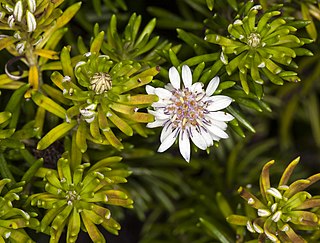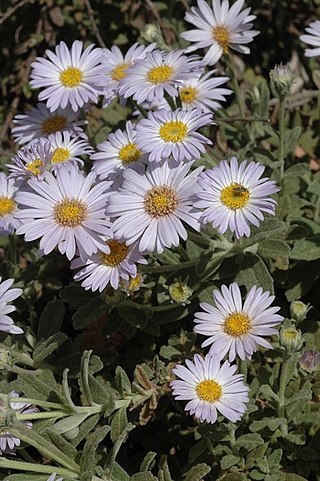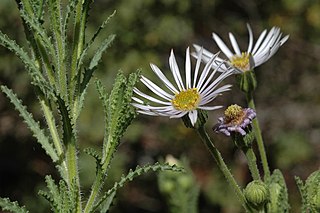
Olearia teretifolia, commonly known as cypress daisy-bush, is a species of flowering plant in the family Asteraceae and is endemic to south-eastern continental Australia. It is a slender, erect to spreading shrub with more or less sessile, linear leaves pressed against the stem, and white and yellow, daisy-like inflorescences.

Olearia argophylla, commonly known as musk daisy-bush, native musk or silver shrub, is a species of flowering plant in the family Asteraceae and is endemic to south-eastern Australia. It is a shrub or tree with silvery branchlets, egg-shaped to elliptic leaves, and white and yellow, daisy-like inflorescences.

Olearia axillaris, commonly known as coastal daisy-bush, coast daisy-bush or coastal daisybush is a species of flowering plant in the family Asteraceae and is endemic to coastal areas of Australia. It is an erect, bushy shrub with densely cottony-hairy branchlets, aromatic, linear to narrowly elliptic or narrowly lance-shaped to egg-shaped leaves with the narrower end towards the base and small white and yellow, daisy-like inflorescences.

Olearia pimeleoides, commonly known as pimelea daisy-bush, is a species of flowering plant in the family Asteraceae and is endemic to southern continental Australia. It is an erect shrub with elliptic, linear or lance-shaped leaves, and white and pale yellow, daisy-like inflorescences.

Olearia ramulosa, commonly known as twiggy daisy-bush, is a species of flowering plant in the family Asteraceae and is endemic to south-eastern Australia. It is a shrub with narrowly elliptic, linear or narrowly egg-shaped leaves, and pale blue, mauve or white and yellow, daisy-like inflorescences.

Olearia myrsinoides, commonly known as silky daisy-bush or blush daisy bush, is a species of flowering plant in the family Asteraceae and is endemic to south-eastern Australia. It is a spreading shrub with hairy branchlets, egg-shaped to elliptic leaves with toothed edges, and white and yellow or mauve, daisy-like inflorescences.

Olearia ballii, commonly known as mountain daisy, is a species of flowering plant in the family Asteraceae and is endemic to Lord Howe Island. It is a dense shrub with crowded linear leaves and small, purplish and white, daisy-like inflorescences.

Olearia exiguifolia commonly known as small-leaved daisy bush, is a species of flowering plant in the family Asteraceae and is endemic to south-western Australia. It is an erect or straggly shrub with broadly egg-shaped leaves with the narrower end towards the base, and white and yellow, daisy-like inflorescences.

Olearia brachyphylla is a species of flowering plant in the family Asteraceae and is endemic to southern continental Australia. It is a densely-branched, aromatic shrub with woolly-hairy stems, oblong to egg-shaped leaves with the narrower end towards the base and small white and pale yellow, daisy-like inflorescences.

Olearia calcarea, commonly known as limestone daisy bush, is a species of flowering plant in the family Asteraceae and is endemic to southern continental Australia. It is a shrub with egg-shaped or broadly spoon-shaped leaves with toothed edges, and white and yellow, daisy-like inflorescences.

Olearia frostii, commonly known as Bogong daisy-bush, is a species of flowering plant in the family Asteraceae and is endemic to Victoria in Australia. It is a low, often straggling shrub with egg-shaped leaves with the narrower end towards the base, and mauve to pink and yellow, daisy-like inflorescences.

Olearia glandulosa, commonly known as swamp daisy-bush, is a species of flowering plant in the family Asteraceae and is endemic to south-eastern Australia. It is a slender, erect, glabrous shrub with sticky, narrowly linear leaves and white or pale blue and yellow, daisy-like inflorescences.

Olearia grandiflora, commonly known as Mount Lofty daisy-bush, is a species of flowering plant in the family Asteraceae and is endemic to a restricted area of South Australia. It is a spreading shrub with egg-shaped leaves and white and yellow, daisy-like inflorescences.
Olearia incondita is a species of flowering plant in the family Asteraceae and is endemic to the south-west of Western Australia. It is a straggly shrub with narrowly elliptic leaves and white or pink and yellow, daisy-like inflorescences.

Olearia laciniifolia is a species of flowering plant in the family Asteraceae and is endemic to inland areas of the south-west of Western Australia. It is an erect shrub with scattered oblong leaves with small lobes on the edges, and lilac, white and yellow, daisy-like inflorescences.

Olearia lanuginosa is a species of flowering plant in the family Asteraceae and is endemic to southern Australia. It is an erect shrub with egg-shaped leaves and white to mauve and yellowish, daisy-like inflorescences.
Olearia lehmanniana is a species of flowering plant in the family Asteraceae and is endemic to inland areas of the south-west of Western Australia. It is a shrub with scattered elliptic or linear leaves that are densely hairy on the lower surface, and pale mauve, daisy-like inflorescences.

Olearia microdisca, commonly known as small-flowered daisy-bush, is a species of flowering plant in the family Asteraceae and is endemic to Kangaroo Island, South Australia. It is a compact shrub with small, crowded, oblong leaves and white and yellow, daisy-like inflorescences.

Olearia stellulata is a species of flowering plant in the family Asteraceae and is endemic to south-eastern Australia. It is a shrub with lance-shaped or narrowly elliptic leaves, and white and yellow or mauve, daisy-like inflorescences.

Olearia teretifolia is a species of flowering plant in the family Asteraceae and is endemic to south-eastern Australia. It is a bushy shrub with lance-shaped, egg-shaped or elliptic leaves arranged in opposite pairs, and white and yellow, daisy-like inflorescences.


















